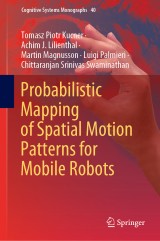Details

Probabilistic Mapping of Spatial Motion Patterns for Mobile Robots
Cognitive Systems Monographs, Band 40
|
117,69 € |
|
| Verlag: | Springer |
| Format: | |
| Veröffentl.: | 28.03.2020 |
| ISBN/EAN: | 9783030418083 |
| Sprache: | englisch |
Dieses eBook enthält ein Wasserzeichen.
Beschreibungen
<div>This book describes how robots can make sense of motion in their surroundings and use the patterns they observe to blend in better in dynamic environments shared with humans.</div><div>The world around us is constantly changing. Nonetheless, we can find our way and aren’t overwhelmed by all the buzz, since motion often follows discernible patterns. Just like humans, robots need to understand the patterns behind the dynamics in their surroundings to be able to efficiently operate e.g. in a busy airport. Yet robotic mapping has traditionally been based on the static world assumption, which disregards motion altogether. In this book, the authors describe how robots can instead explicitly learn patterns of dynamic change from observations, store those patterns in Maps of Dynamics (MoDs), and use MoDs to plan less intrusive, safer and more efficient paths. The authors discuss the pros and cons of recently introduced MoDs and approaches to MoD-informed motion planning, and provide an outlook on future work in this emerging, fascinating field. </div><div><br></div>
<p>Introduction.- Maps of Dynamics.- Modelling Motion Patterns with CT-Map.- Modelling Motion Patterns with CLiFF-Map.- Motion Planning using MoDs.- Closing Remarks.</p>
<div><b>Tomasz Piotr Kucner</b> received his B.Sc. in Computer Management Systems in</div><div>Manufacturing (2011) and M.Sc. in Robotics (2012) at Wroclaw University of Tech-</div><div>nology. In 2018, he received a tekn. dr. (Ph. D.) degree from Örebro University.</div><div>During his PhD studies he was part of KKS research project ALLO and EU FP7</div><div>research rpoject SPENCER. His work in these projects was focussed on building</div><div>spatial models of dynamics. Dr. Kucner currently works as Post-doctoral researcher</div><div>in the Mobile Robotics & Olfaction lab of AASS at Örebro University, Sweden. He is</div><div>mainly involved in the EU H2020 research project ILIAD, where he is working with</div><div>methods for automatic map quality assessment and building spatio-temporal models</div><div>of dynamics.</div><div><br></div><div><b>Achim J. Lilienthal</b> is full professor of Computer Science at Örebro University</div><div>where he leads the Mobile Robotics and Olfaction (MRO) Lab. His core research</div><div>interests are perception systems in unconstrained, dynamic environments. Typically</div><div>based on approaches that leverage domain knowledge and Artificial Intelligence, his</div><div>research work addresses rich 3D perception and navigation of autonomous transport</div><div>robots, mobile robot olfaction, human robot interaction and mathematics education</div><div>research. Achim J. Lilienthal obtained his Ph.D. in computer science from Tübingen</div><div>University. The Ph.D. thesis addresses gas distribution mapping and gas source lo-</div><div>calisation with mobile robots. He has published more than 250 refereed conference</div><div>papers and journal articles and is senior member of IEEE.</div><div><br></div><div><b>Martin Magnusson</b> is currently docent (associate professor) in Computer Science</div><div>at the Center of Applied Autonomous Sensor Systems (AASS), Örebro University,</div><div>Sweden. He received his M.Sc. degree in Computer Science from Uppsala University,</div><div>Sweden, in 2004 and Ph.D. degree from Örebro University in 2009. Dr. Magnusson</div><div>has been vice-chair of the working group for the IEEE/RAS standards for 2D and 3D</div><div>map representations and is deputy chair for the eu-Robotics topic group on robots</div><div>for logistics and transport. His research interests include 3D perception (including</div><div>efficient and versatile 3D surface representations), creation and usage of robot maps</div><div>that go beyond mere geometry, and methods for making use of heterogeneous maps</div><div>with high uncertainty.</div><div><br></div><div><b>Luigi Palmieri</b> is a research scientist at Robert Bosch GmbH - Corporate Re-</div><div>search. His research focuses currently on the topic of motion planning and control in</div><div>cluttered and dynamic environments for wheeled mobile robotics, machine learning</div><div>and social-navigation. He earned his PhD degree in robot motion planning from the</div><div>University of Freiburg, Germany. During his PhD he was responsible for the motion</div><div>planning task of the EU FP7 project Spencer. He currently has the same responsi-</div><div>bility in the EU H2020 project ILIAD. He has co-authored multiple papers at RA-L,</div><div>ICRA, IROS, IJRR, FSR about combinations of motion planning with control, search,</div><div>machine learning and human motion prediction.</div><div><br></div><div><b>Chittaranjan Srinivas Swaminathan</b> is a doctoral student in Computer Science</div><div>at Örebro University, Sweden. He received his M.Sc. degree in Computer Science</div><div>from Örebro University in June, 2017, and his Bachelor of Technology in Mecha-</div><div>tronics from SASTRA University, Thanjavur, India, in September, 2012. His interests</div><div>include motion planning, control and multi-agent coordination in dynamic environ-</div><div>ments. He is also involved in the software integration and motion planning tasks in</div><div>the EU H2020 project ILIAD.</div><div><br></div>
<div>This book describes how robots can make sense of motion in their surroundings and use the patterns they observe to blend in better in dynamic environments shared with humans.</div><div>The world around us is constantly changing. Nonetheless, we can find our way and aren’t overwhelmed by all the buzz, since motion often follows discernible patterns. Just like humans, robots need to understand the patterns behind the dynamics in their surroundings to be able to efficiently operate e.g. in a busy airport. Yet robotic mapping has traditionally been based on the static world assumption, which disregards motion altogether. In this book, the authors describe how robots can instead explicitly learn patterns of dynamic change from observations, store those patterns in Maps of Dynamics (MoDs), and use MoDs to plan less intrusive, safer and more efficient paths. The authors discuss the pros and cons of recently introduced MoDs and approaches to MoD-informed motion planning, and provide an outlook on future work in this emerging, fascinating field. </div><div><br></div>
Investigates recent methods that make it possible to represent the broad range of real-world spatial motion patterns in a compact, yet meaningful way Primarily focuses on creating maps that capture the motion patterns of dynamic objects and/or the flows of continuous media Presents recent research on probabilistic mapping of motion patterns for mobile robots
Diese Produkte könnten Sie auch interessieren:

High-Frequency Oscillator Design for Integrated Transceivers

von: J. van der Tang, Dieter Kasperkovitz, Arthur H.M. van Roermund

149,79 €















